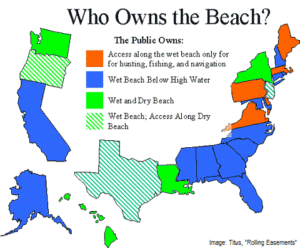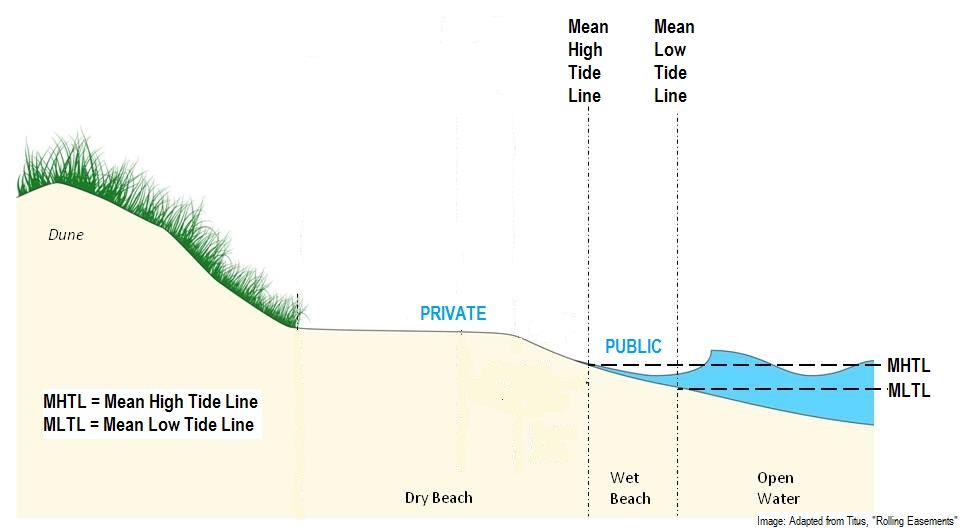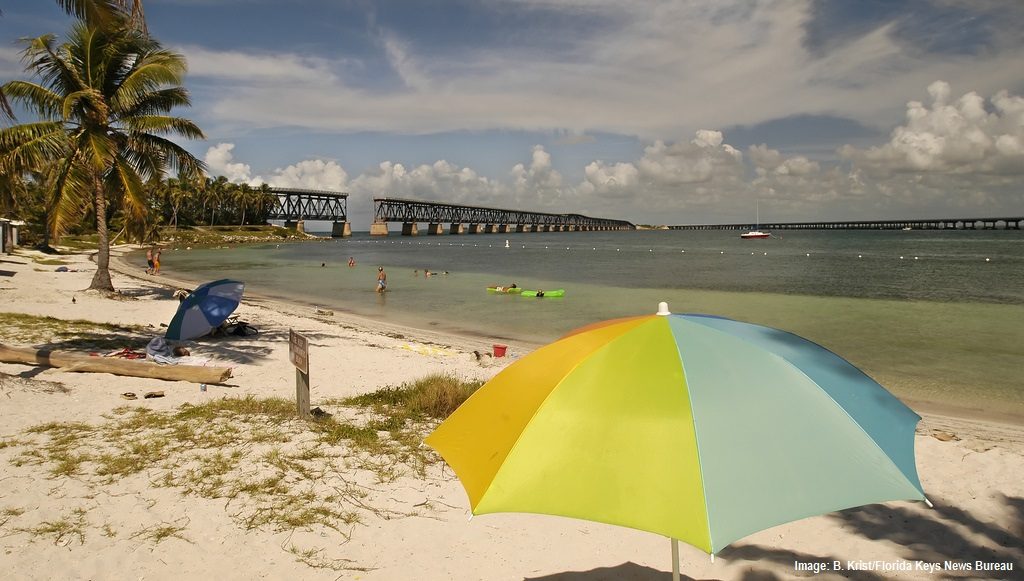To learn more about beach access, navigate to one of the following links:
 In Florida, growing public controversy has arisen pertaining to ongoing loss of beaches and public access to the coast. The controversy revolves around two competing values: the entrenched principal that private property may be held to the exclusion of others, and the long-standing tradition of allowing the nation’s coastlines to be free for public use. This tension between public use and private right, though prevalent in many coastal regions of the country, is particularly intense in Florida due to the low elevation and hundreds of miles of sandy coastline that draws millions of tourists to the state every year.
In Florida, growing public controversy has arisen pertaining to ongoing loss of beaches and public access to the coast. The controversy revolves around two competing values: the entrenched principal that private property may be held to the exclusion of others, and the long-standing tradition of allowing the nation’s coastlines to be free for public use. This tension between public use and private right, though prevalent in many coastal regions of the country, is particularly intense in Florida due to the low elevation and hundreds of miles of sandy coastline that draws millions of tourists to the state every year.
One of the leading concerns is decreasing lateral access, or public access along the shoreline. Lateral shoreline access has been reduced by beach loss, which has been exacerbated by stronger storms, as well as human solutions, such as shoreline armoring. Another common problem is a lack of clear information on public access and enforcement responsibilities across the state, which has led to confusion and conflict in some communities over maintaining public access to and along the shoreline.
Another major concern involves perpendicular access, or public access routes to the shoreline. Florida technically has thousands of designated public beach access points. However, many of these corridors have been compromised by development and adjacent land owners; encroaching vegetation; “hidden, missing, or inaccurate signage; dune walkover access ways closed due to damage or erosion; inadequate or nonexistent parking at public access points; and inadequate or nonexistent beach facilities such as restrooms, lifeguards, sidewalks, or showers.” (Holland, Public Access to the Florida Coast: 1995 Issues at 20–22, Fla. Dep’t of Comm. Affairs 1995).
Beach Users
-
- The public has a right of access along the beaches and shorelines of Florida situated below the “mean high tide line” (see diagram below). Article X, Section 11 of the Florida Constitution clarifies that the state holds the land seaward of the mean high-tide line (MHTL) in trust for the public. This is commonly known as the “Public Trust Doctrine.” Traditionally, the public trust doctrine contemplated fishing, commerce, and navigation as a basis for public access, but more recently has been expanded to embrace recreational uses such as bathing and swimming.
- As part of the public trust doctrine, beaches are essential public coastal recreational resources. Providing coastal recreational opportunities accessible to the public is a fundamental objective set forth in the State’s Comprehensive Plan. Specifically, Section 187.201(8)(b)(2) of the Florida Statutes seeks to “Ensure the public’s right to reasonable access to beaches.
- In Florida, unless the dry sand is already owned for public use (such as in local, state, or federal parks), private beachfront property extends to the MHTL. Although property below the MHTL belongs to the state, private property owners may have the ability to exclude public access to or through their property.

How can I/my group gain/secure access to private beachfront land?
- Acquire the land, or partial rights to the land. See Acquire & Transfer Access
- Enter into private agreement with landowners. See Contract for Access
How can beachfront users increase public access to the shore?
- Become involved in the local, regional, and state planning process. See Plan & Regulate for Access
How can beachfront users enhance access infrastructure, such as parking, access boardwalks, and beach facilities such as restrooms and showers?
- Become involved in the local, regional, and state planning process. See Plan & Regulate for Access
Back to top
Beachfront Property Owners
As a beachfront landowner, what are my legal rights and responsibilities to control public use of my property? What is the scope of my ownership, and what are its limitations?
-
- You have the right to determine who can access your waterfront land:
- Invitees
- Licensees
- Trespassers
- When you choose to voluntarily allow public access to your waterfront, be informed about liability issues and Florida’s Landowner Liability Law (Fla. Stat. § 375.251).
- You have the right to determine who can access your waterfront land:
- You may have the right to exclude access to your waterfront land to the Mean High Tide Line (see diagram below). Limitations to your rights have to do with the potential site-specific application of common law doctrines discussed here. Other limitations imposed by doctrine include the potential for eminent domain and implied dedication. See Use Easements for Access
Besides good will, what are the benefits of allowing access to my waterfront land?
- Tax benefits and affordability. See Use Tax Policy for Access
Tax-based tools designed to promote and preserve access may be rooted in federal, state, or municipal tax provisions, or a coordinated effort among these authorities. Taxation can be used to encourage public access by:
-
- Providing targeted tax relief for certain, more desired uses. Particular uses deemed socially or economically important can be encouraged through either property tax relief or income tax incentives.
- Increasing the cost of less desired uses. Taxes could be levied to discourage uses that would inhibit coastal access.
- Raising revenues to invest in waterfront and coastal access. Taxes on the sale of land, or fees levied on certain activities at places where the public enjoys the beach or shore, can raise money for the acquisition of additional access rights.
- Indemnification from liability for potential injuries on private property (whether sandy beach or perpendicular access corridor to the beach).
- Income potential when land trusts or public entities purchase easements. See Easements for Access
- Control
If you allow access to any type of user (public or a defined group), you have the right to prescribe the kinds of activities and behavior that are acceptable on your property. To clarify this, you can:
-
-
- Draft a Contract for Access with the prospective users. See Contract for Access
- Arrange with the prospective users to buy certain interests in the property. See Acquire & Transfer Access
-
How do I ensure access?
What tools are available to secure and enhance waterfront access or to protect my rights when I provide access?
If someone gets injured while using my land, can I be held liable?
Florida’s Landowner Liability Law protects landowners, should someone become injured while using their land. See Fla. Stat. § 375.251, Limitation on liability of persons making available to public certain areas for recreational purposes without charge. This section, which provides limitation on liability of persons who make their property available to the public without charge for recreational purposes, is intended to encourage private entities to make their property available for public recreational use without being subject to liability for unknown hazardous conditions. (City of Pensacola v. Stamm, 448 So.2d 39, 1st DCA, 1984, petition for review denied 456 So.2d 1181).

Who can own access rights?
Individuals and private user groups, federal, state and local governments, and land trusts can all own access rights. Ownership can also be held in trust by governments acting as trustees for the public at large (the public trust doctrine) or land trusts acting as trustees for the intents of the person who donated the land.
What is traditional land ownership?
Traditional land ownership included ownership of the full title, the right to eject (keep out trespassers), the right to transfer (sell or give the land way). Ownership need not be absolute; it can be split, such as by an easement or a right-of-way.
What is property owned in trust?
Property owned in trust consists of the property itself, the trustee or holder of the property (who will often be the manager of the property), and the beneficiary of the trust, or the person or organization who receives any benefits from the property.Land trusts – though often set up as private charitable organizations rather than actual trusts – assist landowners in conserving their land. Land trusts can act as trustees or whole owners of property. For more information, contact the Florida Communities Trust, North Florida Land Trust, the Conservation Trust for Florida, the Indian River Land Trust, the Land Trust Alliance, or The Trust for Public Lands.
What is a public trust?
A public trust consists of the same three parts as a regular trust: the trust property (or the public’s right to that property), the trustee (the state), and the beneficiary of the trust (the public). The Public Trust Doctrine is a legal concept that applies a public trust ownership to lands that have traditionally been public, such as submerged tidal lands. Because the state owns such land in trust, it cannot give the land to private owners. In Florida, unless the dry sand is already owned for public use (such as state or federal parks), private beachfront property extends to the mean high tide line (MHTL). Although property below the MHTL belongs to the State, private property owners may have the ability to exclude public access to their property.
Government & Public Entities
Municipalities and governments have unique tools available for creating and maintaining access, such as land use planning and regulations that protect natural resources and water quality. Governments have authority from several fundamental legal doctrines to use their regulatory power on behalf of the public, with restrictions.
How can state and local governments plan for coastal access?
Comprehensive planning and harbor planning ordinances can reduce the types of development that are incompatible with access, and provide incentives for developers to provide access to the public. See Plan & Regulate for Access
 How can we enhance existing access or create new coastal access in our jurisdiction?
How can we enhance existing access or create new coastal access in our jurisdiction?
- Purchase land with water access, or acquire access rights from a willing seller. See Acquire & Transfer Access
- Enter into a private agreement with a willing property owner. See Contract for Access
- Establish land use regulations to create or enhance access. See Zone for Access
- Tax related policies and programs can help to reduce assessed values through enrollment in current use taxation or other tax-related programs and policies, selling development rights, or by placing enforceable deed restrictions upon a parcel. See Use Tax Policy for Access
How can we secure or manage existing public access?
- Re-establish rights-of-way.
- Acquire or secure an easement.See:
- Use Easement for Access
- Plan & Regulate for Access
What is the role of land trusts as public interest entities in planning, enhancing, creating, securing and managing access?
Land trusts and conservation organizations can serve as third party interests in addressing access issues. For more information, contact:

